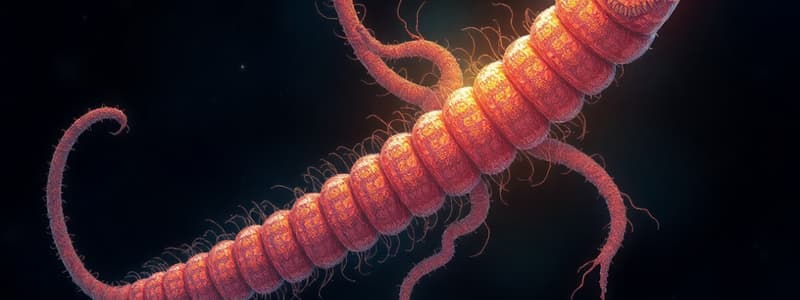Podcast
Questions and Answers
What is the primary definitive host of Echinococcus granulosus?
What is the primary definitive host of Echinococcus granulosus?
- Pigs
- Dogs (correct)
- Cows
- Cats
What occurs in the life cycle of Echinococcus granulosus after eggs are ingested by intermediate hosts?
What occurs in the life cycle of Echinococcus granulosus after eggs are ingested by intermediate hosts?
- Eggs develop directly into adult worms
- Embryos migrate mainly to the liver (correct)
- Only one larva emerges from the egg
- Worms replicate in the intestines
What is the size range of Hymenolepis nana?
What is the size range of Hymenolepis nana?
- 5 to 10 cm
- 3 to 5 cm (correct)
- 10 to 15 cm
- 1 to 2 cm
How are Hymenolepis nana eggs unique compared to other tapeworms?
How are Hymenolepis nana eggs unique compared to other tapeworms?
What characteristic feature is noted for the eggs of Hymenolepis nana?
What characteristic feature is noted for the eggs of Hymenolepis nana?
Which organism does not cause cysticercosis in humans?
Which organism does not cause cysticercosis in humans?
What is the primary method of infection for humans by T.saginata?
What is the primary method of infection for humans by T.saginata?
What is a characteristic of the scolex of Diphyllobothrium latum?
What is a characteristic of the scolex of Diphyllobothrium latum?
What type of cyst disease is caused by Echinococcus granulosus?
What type of cyst disease is caused by Echinococcus granulosus?
Where do the embryos of Diphyllobothrium latum emerge before feeding on copepods?
Where do the embryos of Diphyllobothrium latum emerge before feeding on copepods?
What is the approximate maximum length of Diphyllobothrium latum?
What is the approximate maximum length of Diphyllobothrium latum?
Which of the following is an intermediate host for Diphyllobothrium latum?
Which of the following is an intermediate host for Diphyllobothrium latum?
How long does it take for larvae of T.saginata to grow into adult worms in the small intestine?
How long does it take for larvae of T.saginata to grow into adult worms in the small intestine?
What is the primary function of the scolex in tapeworms?
What is the primary function of the scolex in tapeworms?
How do humans typically acquire cysticercosis?
How do humans typically acquire cysticercosis?
Which tapeworm is identified by having a scolex with hooks and fewer uterine branches?
Which tapeworm is identified by having a scolex with hooks and fewer uterine branches?
What is the main difference between Taenia solium and Taenia saginata?
What is the main difference between Taenia solium and Taenia saginata?
How long does it take for the larvae of Taenia solium to grow into adult tapeworms in the human intestine?
How long does it take for the larvae of Taenia solium to grow into adult tapeworms in the human intestine?
Which of the following statements about Taenia saginata is true?
Which of the following statements about Taenia saginata is true?
What happens to the gravid proglottids of Taenia solium?
What happens to the gravid proglottids of Taenia solium?
What is the intermediate host for Taenia solium in its life cycle?
What is the intermediate host for Taenia solium in its life cycle?
Flashcards
Taenia solium
Taenia solium
A parasitic flatworm that infects humans, causing taeniasis and cysticercosis.
Taeniasis
Taeniasis
The adult stage of Taenia solium, residing in the human intestine.
Cysticercosis
Cysticercosis
The larval stage of Taenia solium that causes infection when ingested by humans, primarily affecting the muscles and brain.
Taenia saginata
Taenia saginata
Signup and view all the flashcards
Scolex
Scolex
Signup and view all the flashcards
Proglottids
Proglottids
Signup and view all the flashcards
Definitive host
Definitive host
Signup and view all the flashcards
Intermediate host
Intermediate host
Signup and view all the flashcards
Echinococcus granulosus
Echinococcus granulosus
Signup and view all the flashcards
Hymenolepis nana
Hymenolepis nana
Signup and view all the flashcards
Hydatid cyst
Hydatid cyst
Signup and view all the flashcards
Diphyllobothrium latum
Diphyllobothrium latum
Signup and view all the flashcards
Unilocular Hydatid Cyst
Unilocular Hydatid Cyst
Signup and view all the flashcards
Multilocular Hydatid Disease
Multilocular Hydatid Disease
Signup and view all the flashcards
Study Notes
Cestodes
- Tapeworms are composed of a scolex (rounded head) and proglottids (flat body segments)
- The scolex has suckers, hooks, or grooves to attach to the intestinal wall
- Proglottids develop from the germinal center, adding new segments to the worm
- Older proglottids at the distal end are gravid (egg-producing)
- Eggs are excreted in feces and transmitted to intermediate hosts (e.g., cattle, pigs, fish)
- Infection in humans occurs when undercooked flesh containing larvae is consumed
- In cysticercosis and hydatid disease, the ingested eggs develop into larvae that cause the disease
Taenia
- Taenia solium (pork tapeworm) and Taenia saginata (beef tapeworm) are important human pathogens
- T. solium adult form causes taeniasis, and larvae cause cysticercosis
- T. solium is identified by its scolex with four suckers and hooks, and its gravid proglottids with 5-10 uterine branches
- T. solium eggs are microscopically similar to T. saginata and Echinococcus species
Taenia solium - Life Cycle
- Adult T. solium worms live in the human intestine
- Infection occurs through ingestion of raw or undercooked pork containing cysticerci
- Larvae attach to the intestinal wall and develop into adult worms (3 months)
- Gravid proglottids detach, releasing eggs into feces, which are ingested by pigs
- Pig embryos develop into cysticerci in the muscle, where they remain until consumed by humans
Taenia saginata - Life Cycle
- Humans are infected by eating raw or undercooked beef
- Larvae attach to the gut wall and take 3 months to grow to 10 m in length
- Gravid segments detach, are passed in feces, and are eaten by cattle
- Embryos (oncospheres) develop into cysticerci in cattle muscle
- The cycle completes when cysticerci are consumed by humans
Pathogenesis & Epidemiology - Taenia species
- Adult tapeworm in the small intestine result in little damage
- Cysticerci can cause inflammation, particularly in the brain (space-occupying lesions), causing symptoms.
- T. solium and T. saginata infections can present as asymptomatic.
- Symptoms may include anorexia, diarrhea, and sometimes proglottids in the feces
- Cysticercosis can lead to headaches, vomiting, and seizures.
- Diagnosis of T. solium includes identification of gravid proglottids in stool
- T. saginata diagnosis involves finding gravid proglottids in stool
- Eggs in stool are less common findings than proglottids
Diphyllobothrium latum
- D. latum (fish tapeworm) causes Diphyllobothriasis
- D. latum scolex has two sucking grooves, unlike other cestodes' suckers
- D. latum eggs are oval with a lid-like opening
- D. latum can be up to 13 meters long
- Infection occurs when raw or undercooked fish containing larvae is consumed
- Larvae attach to the gut wall and mature into adults
- Gravid segments release eggs, which must be in fresh water to embryonate
- The embryos develop into procercoid larvae in intermediate freshwater fish hosts
- Final development occurs in humans upon eating the infected intermediate host fish
Echinococcus granulosus
- E. granulosus (dog tapeworm) causes echinococcosis
- Larval stage forms a unilocular hydatid cyst, often in the liver
- Dogs are the definitive host, and sheep are the main intermediate hosts
- Embryos develop into hydatid cysts, frequently in the liver
- Humans are usually dead-end intermediate hosts
- In the life cycle, eggs are consumed by sheep, and oncospheres migrate to the liver and other organs to form cysts
Hymenolepis nana
- H. nana (dwarf tapeworm) is small (3-5 cm)
- H. nana eggs are directly infective to humans (no intermediate host)
- Infections usually cause no damage or symptoms
- Diagnosing H. nana involves stool examination
- Characteristic 8-10 polar filaments are visible between the egg's membrane and outer covering
Studying That Suits You
Use AI to generate personalized quizzes and flashcards to suit your learning preferences.



